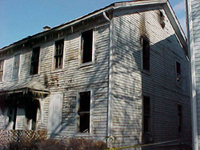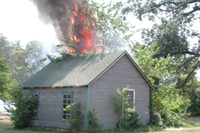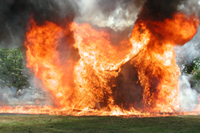

Winter Issue -- 2003
Page 1
Fire Fatalities Studied Using Computer Model
Burning Structures Provide Data to
Understanding Urban Fires
Page 2
Reducing Number of Sailors Needed for Shipboard
Firefighting
Page 3
Canadian Research Has Implications for Smoke Detectors in Homes
Page 4
Reducing Volunteer Firefighter Life Loss
New Program Helps Communities to Be Wildfire Wise
PRINT
FRIENDLY VERSION (PDF format) ![]()
Under the sponsorship of the National Institute of Occupational Safety and Health (NIOSH), NIST has examined the fire dynamics of the 1999 Iowa duplex fire that claimed the lives of three children and three firefighters. In the study, NIST performed computer simulations of the fire using the NIST Fire Dynamics Simulator (FDS) and Smokeview, a visualization tool, to provide insight on the fire development and thermal conditions that may have existed in the residence during the fire.
The NIST FDS computer simulation predicted fire conditions and events that correlate well with information from NIOSH and ATF (Bureau of Alcohol, Tobacco and Firearms) investigations. The critical event in this fire was the onset of conditions consistent with flashover in the kitchen. At this point, the fire started a transition from a single room and contents fire with smoke throughout the structure, to a fire that involved the majority of the structure within approximately 60 seconds.
This quick change in thermal conditions and flame spread through the duplex led to the three firefighters being trapped inside and succumbing to the effects of the fire environment.
Cont. page 2

Front view of duplex.
Dr. Dave Evans of the National Institute of Standards and Technology (NIST) is collecting data on the intensity and duration of radiant heat produced by burning structures. These measurements are used to estimate the heat release rate (a measure of fire intensity) and the potential ignition threat to adjacent combustibles. Understanding the radiant heat produced by burning structures is more important than the temperature of the fire. Thermal radiation emitted from the burning structure can affect people and objects at a great distance from the fire. Smoke and water spray can provide shielding from the full intensity of the thermal radiation emitted from a structure.
The measurements help NIST develop models for conditions where structures play an important part in the spread of fire, such as in some urban-wildland areas or fire in communities following earthquakes.
In cooperation with Chief Chuck Roger, Captain Roy Hodgson, and firefighters from the Odenton, MD Volunteer Fire Department, a small outbuilding was burned as part of a fire department training exercise and data collected to add to the information available.
Cont. page 2

Fire spreads to small structure from burning trees and shrubs.

An intense fire involving asphalt based shingles and siding spreads to the grass surrounding the building.